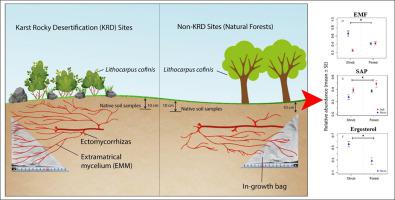Science of the Total Environment ( IF 9.8 ) Pub Date : 2021-10-16 , DOI: 10.1016/j.scitotenv.2021.151016 Muhammad Khalid 1 , Haoxin Tan 1 , Mehran Ali 2 , Asad Rehman 2 , Xinxin Liu 1 , Lantian Su 1 , Saeed-Ur-Rahman 2 , Chang Zhao 1 , Xiaoxiao Li 1 , Nan Hui 3

|
Ectomycorrhizal fungi (EMF) are mutualists that play crucial roles in liberation, nutrient acquisition, transfer of growth-limiting resources and provision of water to host plants in terrestrial ecosystems, particularly in stressed prone climates. In this study, a field-based experiment was performed in Yunnan, China to assess the effect of karst rocky desertification (KRD) and natural forests (non-KRD) sites on the richness and composition of EMF communities. Inert sand-filled mesh bags were employed to characterize the active EMF and quantify the production of extramatrical mycelium (EMM). Results indicated that, EMF exhibited a significant differentiation among KRD and non-KRD sites, richness and diversity were higher across KRD areas, whereas the evenness showed the opposite trend. Ascomycota and Zygomycota were greater across KRD sites, however, Basidiomycota showed no difference across both study sites. The relative abundance of Clavaria, Butyriboletus, Odontia, Phyloporus, Helvella, Russula and Tomentella were higher across the KRD sites, whereas, Clavulinopsis, Endogone, Amanita, Inocybe and Clavulina were higher across the non-KRD sites. It's worth noting that, saprophytic (SAP) fungal community was found to be more abundant in the soil than the mesh bags at both sites particularly at KRD sites, which likely provide more free space and less competition for the EMF to thrive well in the mesh bags. In similar pattern, ergosterol concentration in mesh bags was observed relatively higher at KRD sites than the non-KRD sites. The Entoloma, Amanita, and Sebacina were found to be substantially higher in mesh bags than soil across both sites. Delicatula, Helvella and Tomentella on the other hand, showed higher relative abundance in mesh bags than soil over KRD sites, however they did not differ across non-KRD sites. Taken together, the presented results highlight relationship between the EMF community and the complex KRD environment, which is very important for the restoration of disturbed karst landscapes.



























 京公网安备 11010802027423号
京公网安备 11010802027423号